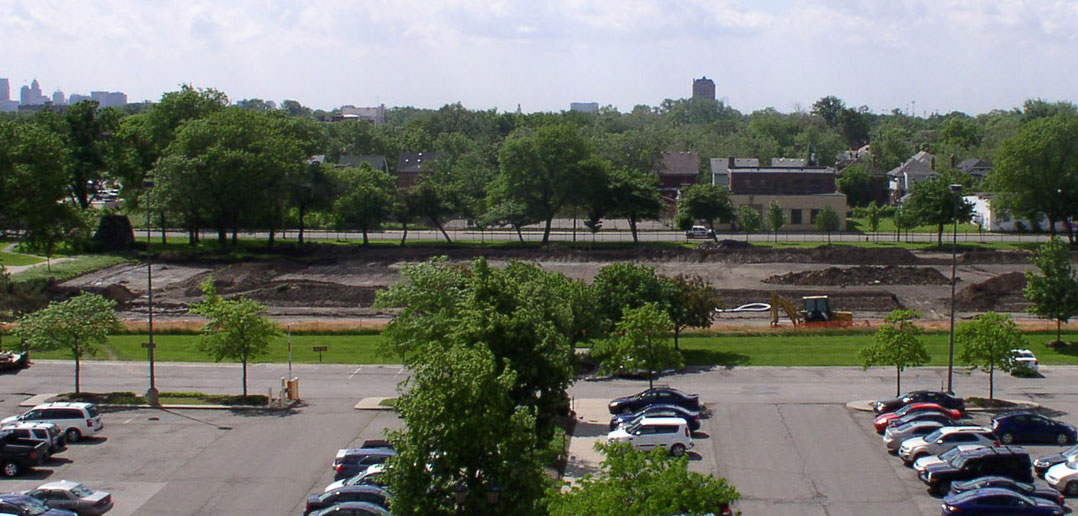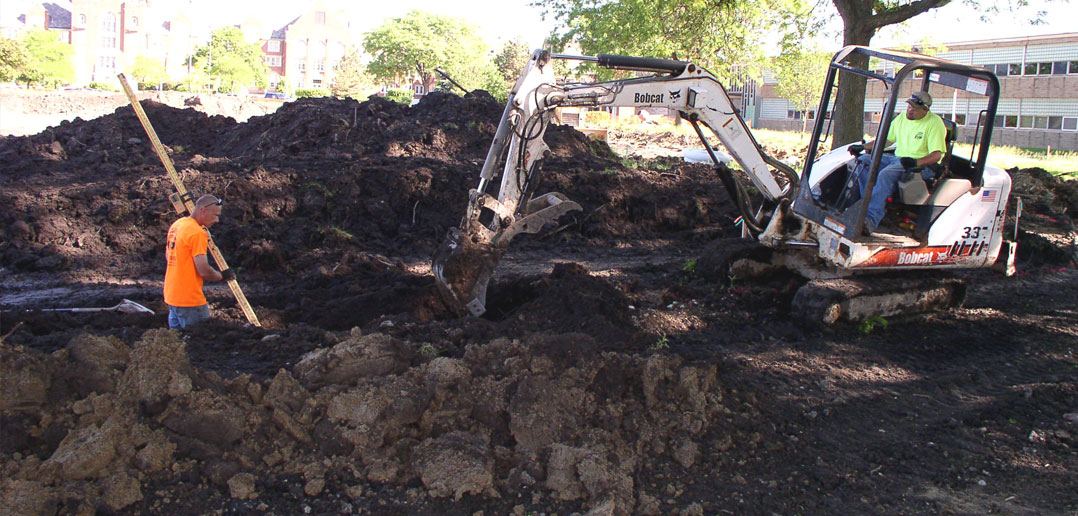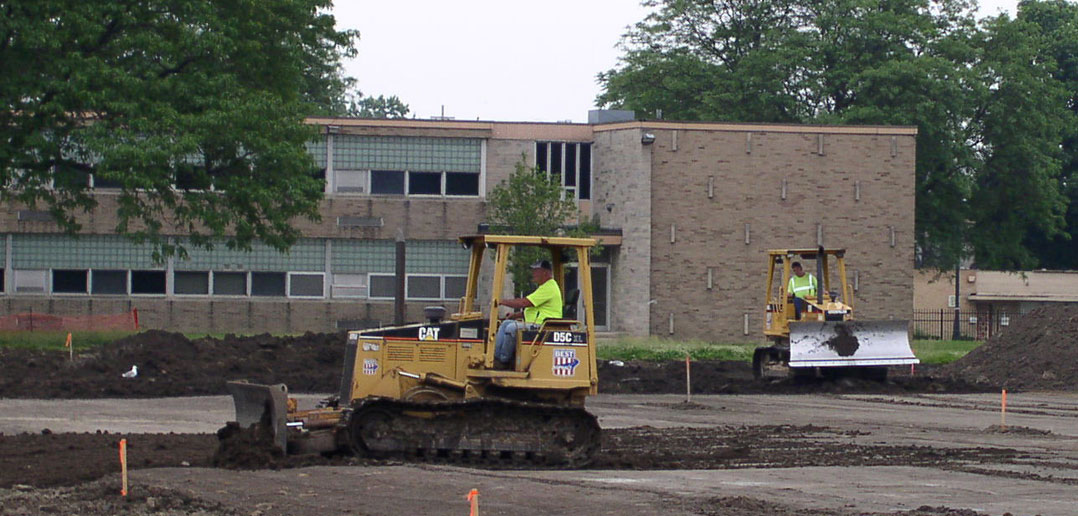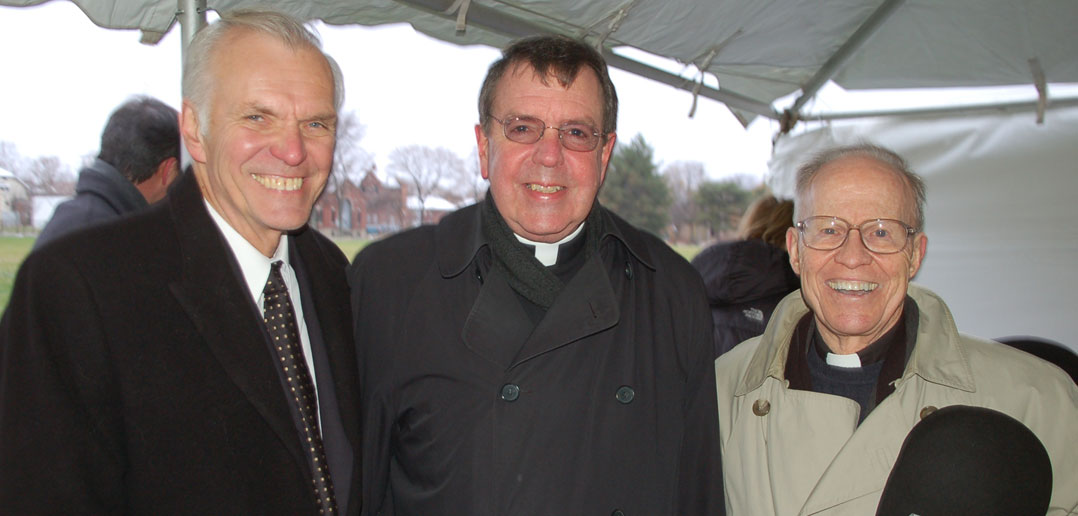Feb 27, 2015
by Daniel Gallio
Running track dream becomes real because of benefactor kindness and the hopeful determination of a Sacred Heart professor.
Father Cassidy returned with exemplary qualifications, including an STL in Sacred Theology and a PhD in Sacred Scripture. He also returned with a dream.
Book. Marathon. Track.
What's that, again?
What's the Plan?
Sacred Heart's building maintenance team has had a long-standing tradition of meeting in the refectory for a 9:30 AM coffee meeting to touch base on the day's work duties. With coffee mug in hand and no doubt with a high-spirited greeting he is known for, Father Cassidy joined the table on his first morning of teaching.
What's the plan, Father Cassidy? What's the program? asked plant manager Jerry Brown. Father and Mr. Brown, an employee at Sacred Heart since 1957, had been friends since Father's seminarian days.
Father thought for a moment. Well, now that you ask, Jerry. Here is my program.' It has three parts.
Book. Marathon. Track.
The table members asked for an explanation. Father's first plan in addition to his teaching duties was to complete a book on Peter's portrayal in the four Gospels (that indeed was published in 2006). The second plan was to run another Boston Marathon (accomplished in 2005).
The third part of the Cassidy program?
To see a running track built someday on the seminary grounds.
Off and Running
I said to myself, There's a better chance I will be president of the United States than for a running track to be built,' laughs John Duncan, who was present at the table that morning. As director of facilities management, Mr. Duncan knew funding for such a major project would be hard to come by. But he also knew how tenaciously Father Cassidy pursues something he believes in.
And Mr. Duncan was right about that. From that morning forward, I looked for opportunities to champion the construction of the track, the intrepid Father Cassidy recalls.
Father's interest in competitive running extends back to his days running track at Sacred Heart High School in Dearborn, Michigan. As a student at Sacred Heart College Seminary, he enjoyed participating in the annual Field Days, a track-and-field event held on the seminary athletic field each spring until the late-1970s. Through the years, Father Cassidy has run many full marathons, including those in Boston and New York.
But Father's running track plan was no whimsical endeavor. There has always been talk of resurrecting the Field Days, and even staging track-and-field competitions among seminaries, as ways to encourage greater physical fitness among the seminarians. Safety is an issue, toooften seminarians and faculty members jogging through the neighborhood are threatened by roaming dogs.
To raise awareness for the needed track among potential donors, Father asked for help from then-vice rector Fr. (now Bishop) Michael Byrnes, another enthusiastic marathon runner. When Father Boguslawski authorized the seminary development office to solicit bequests earmarked for the track, we were off and running, Father Cassidy says. Donations came in but not yet enough to begin construction.
The process extended longer than I expected, Father Cassidy says, noting that during the quest for funds, I was able to complete not one but actually three Boston Marathons!
True to character, Father remained patiently hopeful. A boost in donations resulted from special petition a few years back at Sacred Heart's major fundraising event, the Archbishop's Gala. The event featured an inspiring video of seminarians running through the streets of Detroit training for the Detroit Marathon. Gala donors and other generous friends began to respond so well that three years ago an optimistic Msgr. Todd Lajiness, Sacred Heart's rector, commissioned Mr. Duncan to solicit cost estimates. Funding was short still to sink the first shovel, but for the first time, the goal was definitely in reach, Father Cassidy says.
Honoring Bishop Schoenherr
The funding that pushed the project across the finish line came primarily from Dr. William Grace, a seminary classmate of Father Cassidy's and fellow physical fitness advocate. The two men have remained good friends through the years. Dr. Grace's two substantial gifts came just at the right time, Father says. They testified two-fold: to the doctor's appreciation of the role of athletics in seminarian formation, and that there was significant donor support for the project.
Gifts by a bishop and monsignor with ties to the seminary furthered the momentum. During their rectorships, Bishop (then-Monsignor) Jeffrey Montforton and Monsignor Lajiness allocated funds from unspecified gifts for the advancement of the track project, as well, Father notes.
After eleven years of prayerful promotion, and eleven years of kindhearted response from benefactor—along with final approval from Archbishop Allen Vigneron, the archdiocesan Board of Consultors, and the Sacred Heart Board of Trustee—the third part of Father Cassidy's three-fold dream finally broke the tape. A backhoe broke ground in May 2014 for the one-quarter-mile Kelly green running track that now encircles the seminary's athletic field. Work was completed and seminarians were jogging on the track six months later, in early October.
Incidentally, when Archbishop Vigneron blessed and dedicated the Bishop Walter J. Schoenherr Memorial Track on November 17, 2014, all but one of the original members of that 2004 coffee meeting were present: Mr. Duncan, assistant plant director Milt Burrell, and retired security director Martin Muchitsch. Jerry Brown had passed away in 2007.
It was a point of sadness to me that Jerry died before the track was completed, Father Cassidy says of the beloved member of the Sacred Heart family. One can believe the spirit of Mr. Brown and of the late Bishop SchoenherrDetroit auxiliary bishop, Sacred Heart High School and College alumnus, and accomplished athletewere present on the chilly afternoon of the dedication.
How Is a Running Track Built?
You might think constructing a running track is relatively simple work, but not so, Mr. Duncan explains. First, workers had to remove a 1980s-era satellite dish tower once used by the Archdiocese of Detroit. Arborists relocated trees and cut down others to make way for digging the track. A critical part of the running track puzzle, Mr. Duncan says, was preparing the track for drainage. Storm drains had to be laid and the track precisely graded and sloped to handle rain run-off.
Foresite Design is an expert in this process, Mr. Duncan says of the landscape architectural firm from Berkley, Michigan, who designed and managed the project.
Next, workers using heavy machinery compacted the top soil and aggregate, laid down two layers of asphalt, just like a parking lot, and sprayed the asphalt with two coats of emulsified rubber. Landscapers reseeded the ground inside and around the track. Finally, the running lanes were striped.
Everyone has been using the track, Mr. Duncan says, and not just seminarians. Staff members during their lunch hour, resident priests, faculty members before and after teaching, and even the senior citizens who come to the seminary for lunch can be seen circling track. And best of all, Mr. Duncan says, It was all paid for by private funds.
Daniel Gallio
Daniel Gallio writes from Pittsfield Township, Michigan. He is a member of St. Francis of Assisi Parish, Ann Arbor.






